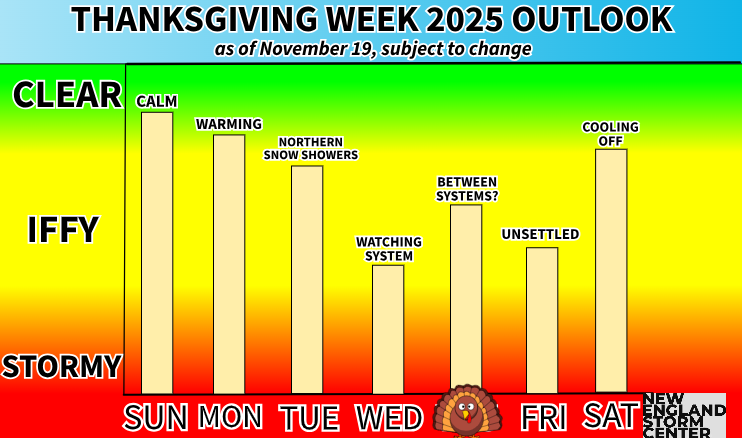Temperatures Set to Climb Once Again Before Slug of Rain Sunday Night
- Tim Dennis
- Mar 13
- 4 min read
An area of high pressure will park itself to Maine's east today, likely settling around Nova Scotia. This will bring about an onshore flow and sea breeze today. As is the case throughout the springtime, this will result in plenty of clouds along with a raw and damp feeling throughout the day. Highs will likely end up cooler than Wednesday given this onshore setup.
Thursday will be the first in what will likely be a large handful of days just like it over the next couple months. It’s creating seasonable temperatures now (widespread 30s north and 40s south, not exactly cold for mid-March), but this setup will hit harder when it creates 40° days in late April (which it will).

Temperatures will begin to rebound back toward above seasonable levels on Friday. An area of low pressure will be shunted to the south of New England due to the aforementioned high near Nova Scotia. This combination will continue a weak onshore flow. Overall, temperatures will likely get a boost from Thursday, especially away from the coast. The coastal plain is currently expected to see an increase over Thursday, but will be the most likely to underachieve in temperatures Friday afternoon.

A deep southerly will begin to develop over the weekend, allowing the real warm-up to begin. Widespread highs in the 50s to low 60s will be possible on Saturday. Sunday will be the peak of temperatures, when a potent southerly low-level jet begins to build over New England, allowing deep southerly warmth to push into New England. This will allow widespread temperatures in the mid 50s north to mid 60s south.

This all comes ahead of New England's next storm, which will involve a deep trough moving across the country. The system's primary low continues to look like it will move well north of New England, dragging its cold front across the region after a warm frontal passage. The main slug of rain will occur along a line ahead of the system's cold front. A secondary area of low pressure may form along the cold front as it approaches New England, allowing for a blossoming of rainfall over southern New England.

While exact rainfall amounts continue to be rather uncertain, signals are still pointing toward a widespread half inch to inch of rainfall for New England. Some ensemble members have begun to trend lower with total rainfall. This comes as the primary area of low pressure and associated energy with this deep trough has continued to trend farther north of New England, not quite coinciding with the axis of deep southerly moisture.
The potential formation of a secondary low pressure south of New England will potentially help boost totals in southern New England. The system may also begin to slow down as it works through New England. These factors are contributing to complicating the rainfall forecasts.
Below: Current precipitation forecast:

The storm will be capable of creating periods of heavy rain Sunday night into Monday as a very strong southerly flow develops. This flow will allow for significant moisture from the deep south to work into New England on basically a conveyor belt working up the eastern seaboard. Precipitable water (PWAT) values may exceed 1" and potentially approach 1.25". This indicates a highly moisture-rich environment.
Below: PWAT values overnight Sunday into Monday:

There will also be a better chance for substantial snowmelt across northern New England compared to last week's storm. The snowpack will already be ripened by the start of this storm, unlike last week's storm, so the snow will be ready to melt immediately. Areas around 1,500-2,000 feet and lower could see a near or total melt-out. Overall, 1-2.5 inches of runoff from snowmelt will combine with total rainfall, which is currently poised to be 0.5-1 inch. Steady snowmelt will begin on Friday before accelerating Sunday into Sunday night.
River rises and ice breakup in rivers will be possible once again with this one. Ice jam flooding will once again need to be monitored. There is also the potential for open water river flooding as well, particularly in Vermont. At this point, minor flooding appears to be the most likely outcome for rivers. This doesn't appear to be a major flood event. The overall extent of river flooding will come down to total rainfall, which has been showing more signs of trending downward than upward.

A strong low-level jet of 70-85mph will also cross the region Sunday and Sunday night. Naturally, not all of this wind will make it to the ground, and southerly winds can often have trouble mixing to the surface due to potential inversion issues. An inversion (which is basically a layer of warmer air aloft located over a layer colder air lower) can act as a barrier, preventing the strongest winds from pushing past it and making it to the surface.
With that said, gusty winds will be likely during this time. They may be at their strongest Sunday afternoon, when mixing is deepest. At this point, gusts of 40-50mph appears to be the most likely outcome, though this could trend higher or lower given the strong low-level jet and strong inversion working for and against wind gusts.
Below: Winds at the 850 millibar level (about 4,700 feet above sea level) Sunday evening:

Beyond this storm, there’s little indication of any late season chill, with above average temperatures remaining highly favored into next week. Ridging looks to be in charge after this system, allowing for a rather persistent southerly and westerly flow. With that said, spring temperature forecasts can tumble quickly, and subtle changes in a front’s position or the development of an onshore flow can cause what was looking like a mild stretch to become cooler.




Comments